Chapter 39. University of Central Florida: Collaboration and Multimedia Classrooms
What Is It?
Multimedia classrooms [http://www.oir.ucf.edu/MultimediaClassrooms.asp] at the University of Central Florida (UCF) are technology-rich learning spaces designed to promote the innovative use of learning resources in teaching and learning. Our greatest strength is not the technology system but the creative faculty and staff who designed the systems and guide and train UCF faculty to use the technologies and learning environments in innovative ways.
The faculty and staff of the UCF Karen L. Smith Faculty Center for Teaching and Learning (FCTL) are using five of the multimedia classrooms to encourage faculty adoption of interactive pedagogical practices to create rich learning environments. (See Figure 1.) Students in the collaboration classrooms are assigned in-class problem-solving activities so that the faculty can assess their learning progress early enough in the semester to allow for adjustments to meet students' learning needs.
Figure 1. Multimedia Classroom for Interactive Pedagogy
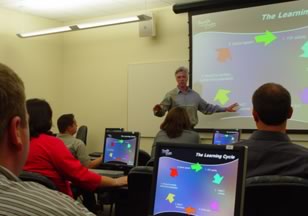
Multimedia and collaboration classrooms are managed through a partnership between the Office of Instructional Resources (OIR), which is part of the Information Technologies and Resources Division [http://www.itr.ucf.edu/], and the FCTL, which is part of the Division of Undergraduate Studies. Both units are part of the Division of Academic Affairs.
The collaboration classrooms provide faculty with a full set of resources that are available in standard multimedia classrooms, as well as student work areas where students work together in teams. (See Figure 2.) Technologies in the collaboration classrooms also include classroom response systems, wired and wireless computers, and software to view the outcome of student learning activities on the centralized multimedia classroom system. Because of the configuration of the workspace, the students can very quickly switch from listening mode to collaboration mode to individual activity.
Figure 2. Student Team Work Areas
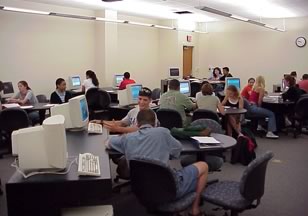
The FCTL has 13 personnel who provide room support, training, and administrative assistance for the faculty who use the five collaboration classrooms. OIR has 32 personnel involved in various classroom support activities for the 240 technology-rich classrooms on a campus of 45,000 students and 1,500 full-time and part-time faculty. The FCTL and OIR directors are advised by representatives from the faculty senate and faculty members from each of nine colleges who are actively involved in their units' activities and services.
The University of Central Florida began offering classes in the fall of 1968 and now has the seventh largest enrollment of any university in the United States. The university provides 92 baccalaureate programs, 94 master's programs, three specialist programs, and 25 doctoral programs. UCF receives more than $100 million in research funds annually and just received authorization to create a new school of medicine. Facilities are currently located at the main campus in Orlando, the Florida Solar Energy Center in Cocoa, and 12 regional campus locations. Multimedia classroom systems are used to support instruction at all of these locations. Integrated multimedia systems are in place in nearly 100 percent of all UCF classrooms. (See Figure 3.)
Figure 3. Integrated Multimedia Classroom
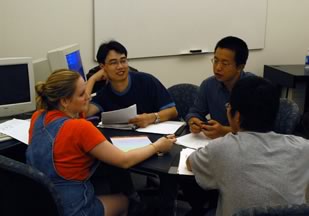
What Happens Here?
In addition to providing multimedia classrooms, the university supports faculty through training, continues planning classrooms, and makes space available for faculty work on projects.
Teaching and learning: Technology-rich classrooms at UCF support faculty and student interaction with high-speed data networks and multimedia tools. Faculty have multiple delivery options for communicating with students; instructional systems tools are designed to meet faculty priorities. Well-trained support personnel help faculty use instructional strategies and tools to their best advantage.
Classroom planning and design: Key personnel from IT&R, facilities planning, and physical plant meet regularly to review the status of UCF construction and renovation projects and confirm that all projects meet UCF guidelines [http://www.fp.ucf.edu/guides/design/Division16.htm#telecommunications]. IT&R also created the Classroom Improvement Project, which provides $300,000 to $400,000 annually for classroom renovations and system upgrades aligned with the guidelines.
Faculty support: OIR provides training and one-on-one support to faculty for multimedia, digital media, and various video-based technologies in classroom settings. The majority of faculty support is provided by the FCTL. Faculty apply to have their courses held in the collaborative rooms, and the FCTL staff trains them in the effective use of technology in the collaborative environment. Preparation for using these environments includes understanding alternative instructional models that create different roles for faculty and students. Training is offered through a funded, semester-long workshop series and through one-on-one mentoring. Technical staff and FCTL staff are available to support the learning environment as needed.
Faculty Multimedia Center: The Faculty Multimedia Center (FMC) in OIR provides an innovative space where graduate students, faculty, and staff can work on multimedia projects, develop presentations, and collaborate on group projects that require shared technologies. OIR personnel bring IT experts and company representatives to the FMC to conduct "shoot outs" of their new products and to allow faculty and staff to consider various academic applications.
How Is Technology Used?
These classrooms provide faculty and students with access to essential visual, oral, graphic, and digital media. Technology includes:
- LCD video projectors
- Computers with a network connection and VGA connection to the projector
- Laptop ports with VGA connection to the projector
- VHS and DVD players
- Wall-mounted whiteboards and/or electronic whiteboards
- Ceiling-mounted overhead document cameras
- Electrically operated projection
- Audio systems that include microphones, mixers, distribution amplifiers, and speakers
- Lighting control systems
- Console and equipment racks to hold the equipment, PC, DVD and VCR player, laptop port, and extra USB ports
- Crestron touch-panel control systems that let faculty easily switch media between various sources and link to a university-wide Web-based maintenance and security system
Chair layout varies from "case study rooms" with fixed seating, to tablet arm chairs that can be moved or fixed tables and chairs in various configurations with PCs for individual and team-based projects.
For the past two years, the FCTL and OIR have helped faculty evaluate and use wireless radio frequency classroom response systems (CRS). Now that the evaluation is complete, the FCTL provides guidance on CRS applications in large multimedia classroom settings. A standardized model has been selected so that faculty and students can use them reliably from room to room. For example, some faculty are using the CRS system to prepare case studies on student learning for their promotion and tenure portfolios, and they conduct classroom research on various methods of teaching and learning.
Innovative pedagogies in specific disciplines are supported by the FCTL. For example, a language pack is installed so that students studying modern language use the computers in the language that they are learning, enhancing their written and verbal skills.
Classroom research has focused on developing new interventions and new learning outcomes for these environments and their effects on technology literacy, teamwork, and critical thinking. Surveys of students in these classrooms over a two-year period (n = 1,337) indicate:
- Technology literacy: We discovered that class year makes a difference in student learning. The more advanced the student, the more likely he or she is to report an increase in skills over the course of the semester. Across all levels, however, 53 percent of respondents reported an increase in their technology skills over the course of one semester. Females are more likely to report an increase in skills than males.
- Teamwork and collaborative learning: About one-third of respondents reported increased learning due to debates, group presentations, group tests, online discussions, peer evaluations, and team research. Two-thirds reported gains from in-class discussion groups.
- Critical thinking: Using Bloom's taxonomy of educational objectives1 to evaluate critical thinking in these classrooms, twice as many respondents reported engagement with the highest outcome level as the lowest (30 percent at the "evaluating" level versus 14 percent at the "knowledge" level). Forty-four percent reported working at the "synthesis" level, with 32 percent at the "comprehension" level.
What Makes the Spaces Successful?
Three major characteristics factor into the multimedia classrooms' success.
Commitment to supporting faculty: UCF is committed to supporting student and faculty success in teaching and learning. The development of reliable, technology-rich, diverse classrooms brings in the outside world. Students can experience real-life situations and develop critical thinking and problem-solving skills that cross disciplines. Faculty are supported in the development of innovative pedagogies that enhance student learning. Faculty innovations in teaching and learning are supported by trained staff and reliable technologies. (See Figure 4.) The integration of the efforts of the OIR and FCTL create a seamless support system for all faculty and students at UCF.
Figure 4. Support for Technology
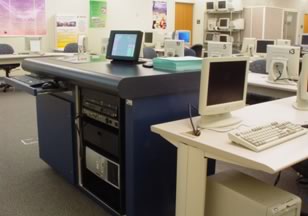
A rapidly growing university: UCF has developed from a relatively small college of 1,948 students in 1968 to one of the fastest-growing universities in the nation with 45,000 students in 2005. Constant growth has made innovation and creativity essential in the design and development of multimedia and collaboration classrooms. Enrollment growth has been matched by growth in the support of effective teaching and learning practices enabled by technology. (See Figure 5.)
Figure 5. Enabling Technology
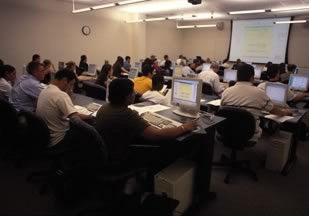
Accumulation of evidence: Faculty are using the research that has come from their collaborative classroom case studies to enhance their promotion and tenure portfolios and earn teaching awards. They are also documenting increased student learning outcomes in their student evaluations.
What Principles Were Behind the Design?
UCF President John C. Hitt's goals and strategic plan for the university [http://www.spc.ucf.edu/SPCMission.html] emphasize the importance of providing student and faculty seamless access to resources that facilitate success. The multimedia and collaborative classrooms provide:
- Transparency so that all types of learning interactions can occur in the classrooms
- A variety of environments that support different learning pedagogies
- Flexibility so that environments can adapt to new ideas and technologies
- Seamless integration and support of technologies
- Support to ensure that faculty and students can use the environments effectively
- Training to keep the faculty and students current
- Information fluency to give students the lifelong learning skills that they need to be effective in the workforce
What Is Unique or Noteworthy?
The multimedia classroom plan embodies several of the university's strategic goals, from an ongoing commitment to research to student exposure to primary research, including offering students the best resources available. In fall 1996, the faculty senate mandated that all new classrooms be designed with multimedia systems in place. Student learning evaluations show a strong student preference for receiving instruction in multimedia classrooms rather than in classrooms without multimedia technology. The Student Government Association even donated funds to renovate an older classroom with multimedia technology. UCF launched the online initiative and the integrated multimedia classroom system and created the FCTL at the same time. Faculty took the next step by integrating all three resources into teaching and learning.
The diverse classroom environments were developed by faculty for faculty, based on research into effective learning environments and the technologies that support them. UCF integrates the traditional with the innovative, using technologies that support student and faculty research, teaching, and learning. Faculty experience in online, collaborative, and multimedia classroom delivery are developing into blended modes of teaching and learning. We plan to implement the lessons learned from innovative activities and incorporate more formal methods of assessment with the scholarship of teaching and learning. We will continue to enrich our classroom environments and encourage faculty and students to actively use our collaboration model.
Endnote
- Benjamin S. Bloom, Taxonomy of Educational Objectives (Boston, Mass.: Allyn and Bacon, 1956).
About the Author
Ruth Marshall is the director of the Office of Instructional Resources in the Division of Information Technologies and Resources at the University of Central Florida.